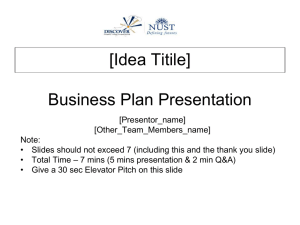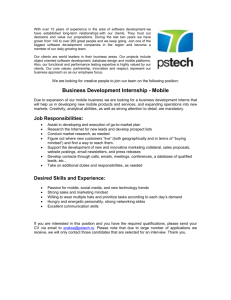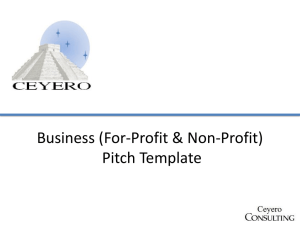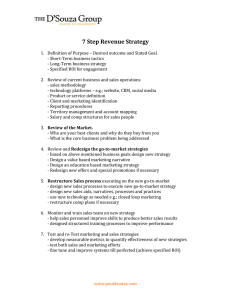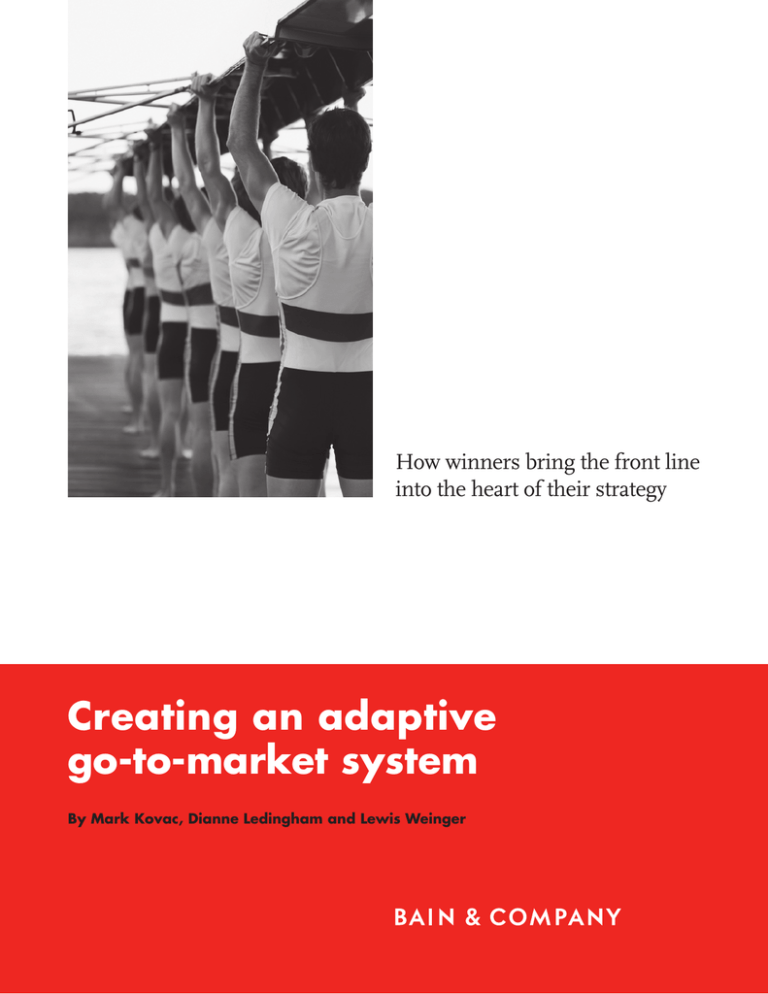
How winners bring the front line
into the heart of their strategy
Creating an adaptive
go-to-market system
By Mark Kovac, Dianne Ledingham and Lewis Weinger
Mark Kovac and Lewis Weinger are partners based in Bain & Company’s Dallas
office. Dianne Ledingham is a Bain partner based in Boston. All three are leaders
of the firm’s Customer Strategy & Marketing practice.
Copyright © 2012 Bain & Company, Inc. All rights reserved.
Content: Global Editorial
Layout: Global Design
Creating an adaptive go-to-market system
How winners bring the
front line into the heart
of their strategy
In late 2006, the mobile phone industry was
booming. Consumers and businesspeople alike
were growing increasingly dependent on the
useful little devices. Two of the business’s stars
were industry leader Nokia, with 35 percent
market share, and up-and-comer Samsung,
with 12 percent. The future for both companies
looked bright.
And then a tsunami hit the industry in the form
of Apple’s pathbreaking iPhone. Suddenly the
old phones—no touchscreen, no built-in music
player, no easy-to-use ecosystem of apps and
services—seemed like grainy black-and-white
TVs up against a sleek color model. Nokia, among
many others, struggled to react. Though it introduced new smartphones based on a proprietary operating system and pursued partnerships
with companies such as Universal Music Group,
its moves were insufficient and too late: By the
end of 2010, its share of the overall wireless
handset market had fallen some six percentage
points. Only recently have new CEO Stephen
Elop and his team begun positioning the company for renewed growth.
Facing the same circumstances, Samsung reacted nimbly and aggressively. It plunged into
smartphones, harnessing a market-sensing and
development system that quickly turned out
innovative devices. It was one of the first to
adopt Google’s Android operating system, an
effective rival to Apple’s technology. It created
an appealing line of product offerings under the
Galaxy brand. It also anticipated the marketshare battles to come, moving quickly to provide carriers with the products they needed and
expanding its distribution channels. Despite the
disruption—or maybe because of it—Samsung
gained nearly six points of market share between
2006 and 2010.
Nokia and Samsung are archetypes of today’s turbulent marketplace—not just in mobile phones.
Tidal waves of all sorts continue to hit one industry after another. A leading market share
can evaporate quickly. A strategic move, such as
an acquisition or expansion into a new market,
can backfire with little warning. Many companies
in this unpredictable world have wound up like
the Nokia of a few years ago, unable to maintain
momentum as the ground shifted under their
feet. A much smaller number—including the
mutual fund company Vanguard, the European
toolmaker Hilti, and Samsung—have adapted
quickly to the changes, moved forward successfully and taken their growth to new heights.
What accounts for the difference? Conventional
explanations—better technology, deeper pockets,
better-known brands—aren’t sufficient. Neither
are the “silver bullet” stories often favored by
outside analysts and journalists. The real difference is that nearly all the successful companies,
the ones that have moved quickly and nimbly
to adapt to the new environment, have created
distinctive go-to-market systems. They have built
adaptability and repeatability into the neural
wiring of their daily operations. They can make
decisions quickly without bumping into walls
created by functional silos, enabling them to
respond effectively to marketplace changes.
They can incorporate an acquisition or launch a
new product smoothly and successfully because
they are built to do so.
Every company has a go-to-market process, of
course. That’s why they have functions called
Sales, Marketing, Product Management and so
forth. But these functions at many companies
are like fiefdoms, isolated from changes in the
marketplace, from their own company’s strategic priorities, even from each other. The handoffs from one fiefdom to the next are incomplete.
There’s a disconnect between what the sales
channel understands and what it is asked to sell.
Too often, frontline employees are baffled by
the company’s strategy.
A powerful go-to-market system is quite different. It builds in fast, regular feedback so
that the company remains in sync with its market. It is based on a handful of key capabilities,
1
Creating an adaptive go-to-market system
each one world-class and superior to competitors. Above all, it is integrated, with seamless
coordination between design and delivery functions. The litmus test for all these traits—the
linchpin that makes it all work in front of the
customer—is a front line that deeply understands the strategy, executes it flawlessly and
brings passion and excitement to the task.
We have seen these differences repeatedly in our
own work with clients. To test our observations,
we surveyed 225 marketing and sales executives
in some 60 different companies, including leaders and laggards in both B2B and B2C markets.
We conducted in-depth analyses of 50 other companies in businesses ranging from IT services
and pharmaceuticals to insurance and retail. We
also interviewed dozens of our own partners to
determine whether our findings rang true in
markets around the globe.
All this research pointed to the same conclusion: A robust, integrated go-to-market system
is one central difference today between companies that succeed and companies that fail,
between those that grow and those that scramble merely to stay in place. In the rest of this
article, we will describe the essential elements
of this system and show how companies create
and reinforce these elements. We will also offer
a list of diagnostic questions about your front
line—questions that will enable you to determine
whether your go-to-market system is in need of
a tune-up or a complete overhaul.
The bridge to growth
Let’s begin with the basics. Growth is nearly every
company’s top priority. A Bain survey of 2,300
global companies revealed that the typical management team promises to increase revenue at
twice the market average and earnings at four
times the market. But that level of growth is elusive. Just 9 percent of these companies actually
averaged annual revenue and profit growth of at
least 5.5 percent (while earning their cost of capital) over the 11-year period from 2000 to 2010.
2
The reasons for the difficulty are scarcely a
mystery. New technologies are cropping up
everywhere. They blur competitive boundaries,
undermine established business models and
shorten product lifecycles. Companies find themselves facing unfamiliar rivals. They struggle
every day to keep up with shifting customer
wants and needs. In this kind of turbulence,
even a business’s own strategic moves, such as
launching a new product or moving into a new
market, can overload its go-to-market system,
sabotaging its plans for growth. SAP, the big
software company, tried a few years ago to move
aggressively into the software-as-a-service space.
But the product design faced some challenges,
and the company didn’t sufficiently adapt its
go-to-market system—for instance, it failed to
add effective channels for reaching small-tomidsize companies. As a result, it signed up far
fewer customers than it had hoped. With the
recent purchase of SuccessFactors, a leader in
cloud-based software, SAP has invested in building its companywide cloud capabilities. The new
platform will help SAP expand its cloud offerings
and leverage its extensive go-to-market reach,
this time targeting large and midsize enterprises.
The companies that have sustained their performance over 10 years—that 9 percent—manage
to grow despite any turbulence. If you study
this group closely, you learn an interesting fact:
Nearly all of them have a different relationship
with their customers. Far more than other companies, their customers are loyal, passionate
advocates—the kind of buyer who loves doing
business with a company. Far fewer customers
are dissatisfied. The average Net Promoter®
score of the growers is 30, compared with just 13
for other companies. (A metric widely used by
customer-focused companies, the Net Promoter
score, or NPS®, is based on the question, On a
zero-to-10 scale, how likely are you to recommend the company to a colleague or friend? A
company’s NPS is the percentage of promoters—
those responding with scores of 9 or 10—minus
the percentage of detractors—those giving
scores of zero to 6.)
Creating an adaptive go-to-market system
The link between advocacy and growth is apparent in the other direction as well: The loyalty leader in nearly every industry grows at a rate greater
than twice the industry average. Again, little mystery. A company that masters the art of delivering
exceptional customer experiences earns loyalty
and advocacy among its customer base. Loyal
customers, in turn, buy more products, stick
around longer, cost less to serve and sing the
company’s praises to friends and colleagues. It’s
a virtuous cycle. No wonder the companies that
achieve it are able to sustain their growth.
How can we minimize the impact of a supplychain disruption or a spike in energy prices? A
world-class go-to-market system helps a company synchronize its operations with the everchanging marketplace, enabling it to make
good, quick decisions about issues like these.
In Bain & Company’s survey, executives from
high-performing companies were far likelier
than those from lagging companies to cite their
organization’s ability to adapt to changing market conditions and strategic priorities as a distinct competitive advantage (see Figure 1).
This is precisely why an integrated go-to-market
system can be so powerful. It is the missing link
between a company’s strategy—its decisions
about where to compete and how to win—and
the exceptional customer experiences that are the
ultimate path to success. Such a system enables a
company to identify attractive target customers
and design value propositions tailored to those
customers’ needs and to the company’s strengths.
It also enables the company to deliver these offerings to the marketplace and to continually refine
them based on fast, accurate customer feedback
(see the sidebar “Design and deliver”).
Leaders monitor competitors closely and connect their findings with what they learn from
their own customers. They search out rapid,
direct customer feedback through a variety of
channels. The financial software company Intuit, for example, gathers Net Promoter data
from a sample of its customers after every interaction with the company. It has created an
Inner Circle of 6,000 users to generate and
rank-order suggestions for improvement. It
actively solicits B2B customer feedback through
online forums, surveys and beta testing.
Building a world-class go-tomarket system
Our research and experience have turned up
remarkable similarities in the go-to-market
systems that produce sustainable, profitable
growth. Companies with world-class capabilities
in this area almost always adhere to just three
fundamental principles, which we think of as
Stay in Sync, Focus on a Few and Tie It All Together. Let’s look at each one.
1. Stay in Sync. The system needs to shift along
with market and strategic requirements. Every
company today must respond rapidly to whatever turbulence is roiling its industry, and it
must make good decisions about the inevitable
trade-offs. Should we try to leapfrog a competitor’s
new technology or play catch-up? How much should
we invest to meet new consumer preferences, such as
for organic or environmentally sustainable products?
All this input enables Intuit to pursue—and prioritize—continuous improvements in product
development, sales, marketing, pricing and
distribution. For instance, it incorporated a live
support community in its popular TurboTax program and streamlined Quicken’s user interface.
It learned that it had to work more closely with
retailers and so created category captains to
help retailers understand how to sell each kind of
product. The result: annual revenue growth averaging 13 percent over the past 10 years, fueled
partly by a massive share gain in the retail channel (50 percent to 90 percent for TurboTax alone).
A company with a strong go-to-market system
can treat potentially disruptive technologies such
as social media as opportunities rather than as
threats. JetBlue Airways, for instance, actively
monitors chatter on sites such as Facebook and
Twitter. During the “Snowmageddon” of December 2010, the airline’s real-time Twitter service
recovery force effectively converted stranded
passengers from detractors to promoters by
3
Creating an adaptive go-to-market system
Design and deliver
A go-to-market system builds customer advocacy by creating a superior customer experience
Point of departure
Gotomarket system
Business unit strategy
Design
• Where to play
• How to win
• Fullpotential
roadmap
Point of arrival
Delivery
• Acquire more
attractive customers
• Grow share
of wallet with
existing customers
• Identify the most
attractive target
segments and
their needs
• Design better value
propositions than
the competition
Customer experience
Exceeding expectations
creates advocates who…
• Stay longer
• Buy more
• Refer more
• Cost less to serve
• Provide rich feedback
An integrated go-to-market system comprises dozens of capabilities that, together, build a
bridge between a company’s strategy and the exceptional customer experiences that are
the ultimate driver of customer advocacy and loyalty.
Capabilities that form the go-to-market system
Gotomarket system
Business
unit strategy
Design
capabilities
• Mobilization
• Customer
insights
• Customer
messaging
definition
• Market &
competitive
intelligence
• Definition
of sales &
support model
Messaging
• Evaluation
of choices
• Offering
definition
• Category management
• Portfolio/lifecycle management
• Product development
Pricing
• Pricing strategy
• Product pricing
• Pricing tactics
Branding & marketing
• Branding
• Category marketing
• Demand generation
Closed
loop
feedback
system
Salesforce & channel management
Sales & support
• Strategic
fact base
• Customer
segmen
tation
Customer
experience
Product/service management
Value
proposition
definition
Offering
Customer
and market
intelligence
Delivery
capabilities
• Tools
• Channel mix
• Performance
• Targeted offering
• Resource deployment management
Postsales support
• Customer support
• Process improvements & innovation
Enablers: Organization, decision roles, metrics, culture, IT, innovation, operations and so on
A company’s key go-to-market capabilities fall into two buckets, design and delivery. For example,
the design capabilities of a top performer like Intuit, the financial software company, range from
customer segmentation and intelligence to the definition of the company’s sales and support model.
Its delivery capabilities run the gamut from product and service management to post-sales support.
4
Creating an adaptive go-to-market system
Figure 1: High performers excel at adapting their go-to-market systems
Do the following statements accurately describe your company?*
• We are the best in our industry at capturing learning and driving
continuous improvement in sales, marketing, pricing and distribution.
This is a competitive advantage.
Leaders
63%
Laggards
0
20
+14%
49%
40
60
80
Leaders
• We understand our performance relative to competitors on
customer advocacy metrics.
• When we pursue growth adjacencies, we quickly and effectively
adapt our sales, marketing, pricing and distribution to ensure the
success of each adjacency.
82%
Laggards
0
20
40
60
40
60
20
80
100%
67%
Laggards
0
100%
+22%
53%
Leaders
• When there are significant changes within our industry
(e.g., competitive moves, etc.), we quickly and effectively adapt
our sales, marketing, pricing and distribution in response.
80
75%
Laggards
20
+24%
58%
Leaders
0
100%
44%
40
60
+23%
80
100%
*Percentage of respondents who said they “strongly agree” or “agree more than disagree.” N = 50 high performers; 45 laggards from B2B customer survey
quickly rebooking them on new flights—and
the efforts were witnessed by JetBlue’s 1.6 million
Twitter followers. JetBlue estimates that service
recovery over Twitter is more productive than
recovery delivered over other channels and that it
can handle five customer-related tweets for every
one call handled through a call center.
The steady flow of feedback also helps the high
performers adapt their go-to-market system to
accommodate industry disruptions, competitor
acquisitions and their own moves into adjacent
markets. Hess Corporation, a global energy
company that began in oil, recognized the need
to expand beyond its core business over time.
Serving commercial and industrial customers,
the company’s Energy Marketing business unit
first focused its efforts on gas, achieving leading positions in many markets. The team then
began expanding into a third commodity, electric
power, as the regulatory environment allowed—
for example, moving into Pennsylvania following
that state’s 2009 deregulation of the electricity market. Energy marketing revenues have
grown 9.5 percent yearly since 2004, with
annual margin growth of 15 percent in an industry where annual demand growth was only
around 2 percent during that period. In addition
to fueling growth, the ability to capitalize on market changes while continuing to meet different
customer needs enabled the Energy Marketing
unit to achieve the leadership position in customer loyalty and advocacy in markets it serves.
2. Focus on a Few. A handful of capabilities
should be truly best in class. Leaders of highperforming businesses understand that, like
championship sports franchises, the best teams
don’t necessarily have stars at every position. So
they pursue world-class performance only in the
handful of capabilities that are most critical to
success. The ability of leading companies to identify where they must excel to seize a competitive
edge over their rivals emerged clearly in the Bain
survey findings (see Figure 2).
What are the go-to-market capabilities a company
needs most? One is the ability to design crystalclear requirements for product and service offerings geared precisely for target customers. That
5
Creating an adaptive go-to-market system
includes delivering what the customers want and
nothing more that could distract from the value.
When the environment is changing rapidly,
marketers face the temptation to play it safe, to
develop products and services that try to be all
things to all people. (Steve Jobs famously said
that the hardest decisions were always about
what to leave out of Apple’s products, not what
to put in.) For B2B companies, world-class sales
and channel-management capabilities are also
likely to be critical. For B2C companies, superior
branding and marketing skills are essential.
One company that focuses on just a few essential
capabilities is the Vanguard Group. Now one of
the world’s largest investment management
firms, Vanguard has built its entire business on
a few highly differentiated capabilities. Its target
customers are investors who value low-cost
investment vehicles and who want to remain
with one investment company for an extended
period of time. Its products—including both index and actively managed funds—carry expense
ratios that are a fraction of industry averages.
Vanguard provides highly responsive service to
its customers, and it structures both its product
line and its pricing policies to reward long-term
relationships. A second example is Hilti, the
Liechtenstein-based tool company. Hilti’s direct
salesforce of 13,000 representatives, unique in
its industry, visits construction sites and solicits
feedback from customers that then drives product innovation. Innovation, in turn, has helped
the company sustain a consistent 6 percent
growth for more than 50 years.
Selling organizations often stumble as they try
to reach diffuse, ill-defined customer segments
through channels that are poorly suited to the
job. A clear understanding of target-customer
needs helps go-to-market leaders organize their
sales resources and select the channel mix best
suited to reach these customers. Since these
leaders anticipate customer needs better than
rivals, they can deploy their sales resources to
the highest-value areas within each customer
segment, selling channel and geography. Pharmaceutical manufacturer AstraZeneca, for
example, used its superior market-intelligence
capabilities to develop a new Internet-based sales
Figure 2: High performers excel at a few differentiated capabilities
Do the following statements accurately describe your company?*
Leaders
• We have a clear set of product/service requirements that delivers
a compelling value proposition for our target customer segments.
80%
Laggards
0
20
67%
40
Leaders
• Our ability to develop and create new products and services is best
in the industry. This is a competitive advantage.
Laggards
0
20
60
80
+17%
39%
40
60
80
20
+26%
63%
40
60
80
Leaders
• Our mix between direct channels (e.g., salesforce, online store)
and indirect channels (e.g., retailers, distributors) aligns with our
target customer segment strategy.
20
100%
91%
Laggards
0
100%
89%
Laggards
0
100%
56%
Leaders
• We have a strong understanding of the economics and investment
levels required for our direct sales and indirect channels.
+13%
76%
40
60
80
+15%
100%
*Percentage of respondents who said they “strongly agree” or “agree more than disagree.” N = 50 high performers; 45 laggards from B2B customer survey
6
Creating an adaptive go-to-market system
portal called AZ Touchpoints. Sales reps can now
dedicate more time to building relationships with
physicians, using data gathered at touchpoints to
inform their sales approaches. The result: lower
selling costs and greater salesforce efficacy.
3. Tie It All Together. Leaders foster integration
and clear decision making throughout the organization and across all channels. Many companies
fail to deliver their value propositions effectively
across multiple channels. Their sales and marketing efforts wind up trapped in silos or stymied
by slow decision making. Companies with highperformance go-to-market systems don’t face
these difficulties. The Bain executive survey found
that the leaders integrate design and delivery capabilities, tailoring each offering and marketing
message to its channel while maintaining a cohesive approach overall (see Figure 3). They break
down the silos and establish simple, clear decision
roles and processes. They know exactly who is
responsible for pricing tactics, product launches,
market intelligence and every other aspect of the
system—and since decision roles are transparent,
everyone in the organization knows it as well.
One company that has successfully integrated its
go-to-market system in this manner is Scania,
the Sweden-based truck manufacturer. To an
extent unmatched by the competition, it puts
the customer experience at the heart of its strategy, from product design to the aftermarket
value chain. It communicates directly with truck
drivers, commits to resolving easy-to-fix problems
within days and uses the full range of feedback
channels from drivers and other end users in its
product development processes. On the shop
floor, cross-functional collaboration and working
groups help employees understand the value of
their delivery to the next stage in the work flow,
shortening time to market for new products and
services. Internal rules of conduct, codified in a
document titled “How Scania is Managed” and
embraced by managers, line employees and
Scania affiliates, describe the decision-making
structure and key processes that govern the
company. “Scania is the most focused and bestperforming truck manufacturer in the world,”
said one industry expert in 2011.
Figure 3: High performers integrate how they go to market into a cohesive system
Do the following statements accurately describe your company?*
Leaders
• Our pricing, messaging and sales and support are integrated
appropriately across channels.
85%
Laggards
0
20
+29%
56%
40
60
80
Leaders
• Our frontline employees understand our strategy.
They are fully in line with top management.
76%
Laggards
0
20
+33%
43%
40
60
80
20
40
60
80
Leaders
• We track a focused set of sales metrics that are tied to our
strategic goals and are actively used by key members of sales
and channel management.
20
100%
82%
Laggards
0
+22%
70%
Laggards
0
100%
92%
Leaders
• Our frontline employees passionately execute our vision
of what we want customers to experience.
100%
+20%
62%
40
60
80
100%
*Percentage of respondents who said they “strongly agree” or “agree more than disagree.” N = 50 high performers; 45 laggards from B2B customer survey
7
Creating an adaptive go-to-market system
Key to success: The front line
What makes all these principles work is simple:
It’s a company’s front line.
Frontline employees are central to every highperforming go-to-market system, the linchpin
that makes it all work. The front line represents
a company’s value proposition and brand promise in the eyes of the customer. Think of the
friendly, helpful staff in a Four Seasons hotel,
the legendary account executives at IBM or the
genial flight attendants and gate personnel who
work for Southwest Airlines. It’s the commitment
and enthusiasm of those individuals that help
these companies realize their goal of providing
a great customer experience.
In our survey, frontline engagement was the
No. 1 factor separating leaders from laggards—
which means, in effect, that if you don’t get the
frontline part right, you are failing to get the
system right. (See the sidebar “Does your front
line measure up?”) As it turns out, nearly every
one of the go-to-market leaders we studied engages the front line as the embodiment of its
go-to-market system. Samsung mobilized its
entire organization to confront the challenge of
the iPhone. Intuit asks employees to spend 10
percent of their time in unstructured activities to
improve the customer experience, and it has
created an online brainstorming tool to facilitate
idea sharing across the company. Vanguard expects employees to drive process and service
improvements, and captures the ideas through
its “voice of the crew” feedback mechanism. In
8
many selling situations, the frontline salesforce
literally embodies the organization’s go-to-market
strategy. Hilti’s field representatives not only
study the customer’s needs and propose new
products that will meet those needs, they also
stay involved after the sale, working closely with
customers. “This is why we know exactly what
our customers want,” explains board chairman
Pius Baschera. “Our research and development doesn’t ‘invent’ products in a vacuum in
the hope that these will appeal to the market.
As a rule, they translate the customer’s actual
wishes—a hard enough task in itself.”
These three principles—Stay in Sync, Focus on
a Few and Tie It All Together—are easy to articulate but tough to get right. Bureaucracies resist
change. Functional leaders may feel threatened.
People accustomed to the cloistered confines
of their own silo may find it hard to break down
the walls and let in the sunlight of cross-functional collaboration.
But what’s the alternative? The turbulence in the
marketplace isn’t going away. A company that
fails to create an effective go-to-market system is
likely to wind up like Nokia in 2007, struggling
mightily to confront a challenge it hadn’t adequately anticipated. On the positive side, the
payoffs from creating such a system can be extraordinary. Samsung, Hilti, Vanguard and the
other leaders have catapulted themselves to the
top ranks of their industries—not on the basis of
deeper pockets or some dazzling new technology, but simply on the basis of going to market
better than everybody else.
Does your front line measure up?
Any top-performing go-to-market system depends on the engagement and passion of frontline
employees, which should be ground in their full understanding of your strategy. Ask yourself
these questions to determine whether your system is hitting on all cylinders, needs a quick
tune-up or is due for an overhaul.
•
Does your front line know which target customers and sales opportunities to pursue and
which ones they shouldn’t waste their time on?
•
Does your front line live and breathe the key attributes of your brand?
•
Does your front line consistently and effectively position your company’s value proposition
against competitors, based on the most recent competitive intelligence?
•
Do you know how your front line performs on key customer advocacy metrics?
•
Can you identify the interactions between frontline employees and customers that have
the greatest impact on customer advocacy?
•
Do you have closed-loop learning processes in place to get customer feedback to your
front line within 24 to 48 hours?
Key contacts in Bain’s Global Customer Strategy & Marketing practice are:
Global:
Mark Kovac in Dallas (mark.kovac@bain.com)
Americas:
Dianne Ledingham in Boston (dianne.ledingham@bain.com)
Lewis Weinger in Dallas (lewis.weinger@bain.com)
Europe:
Carsten Schymik in Munich (carsten.schymik@bain.com)
Philip Skold in Stockholm (philip.skold@bain.com)
Asia-Pacific:
Melanie Sanders in Sydney (melanie.sanders@bain.com)
For additional information, please visit www.bain.com
For more information, please visit www.bain.com

